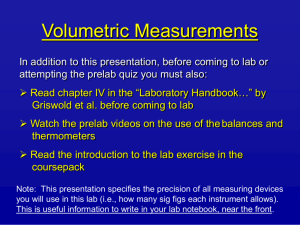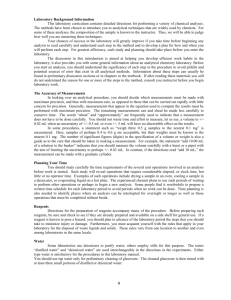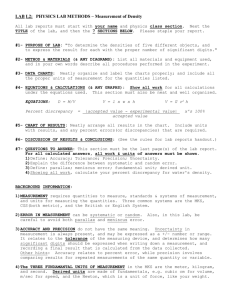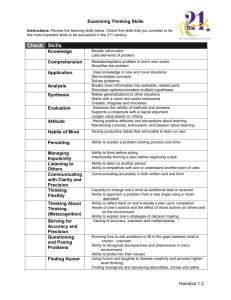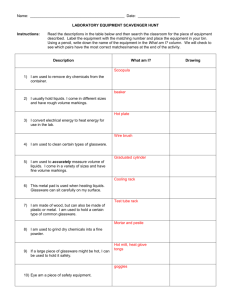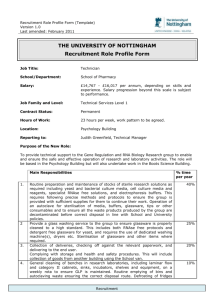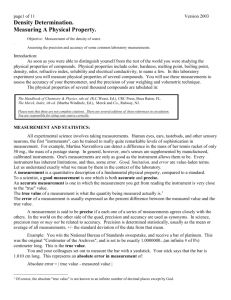Measurements, Accuracy, and Precision Laboratory Overview
advertisement
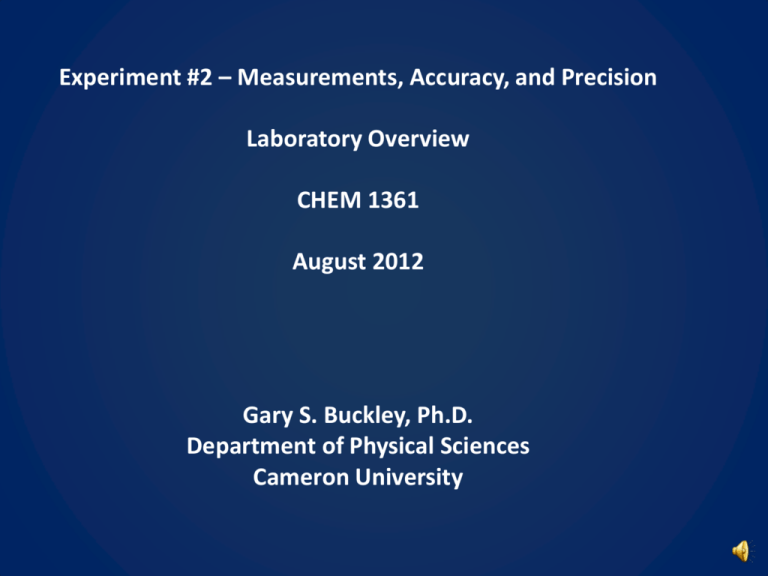
Experiment #2 – Measurements, Accuracy, and Precision Laboratory Overview CHEM 1361 August 2012 Gary S. Buckley, Ph.D. Department of Physical Sciences Cameron University PowerPoint Notes Each lab will be accompanied by a short PowerPoint presentation showing some of the basic ideas of the lab. Viewing is optional to you, but viewing them may give you a better idea of what the key aspects of the experiments are. It may also help with the prelabs. This first one runs a little long – 17 slides. Most will be on the order of ten slides. If you decide you want to print these presentations, I suggest you use either Black and White or Grayscale in the Print box. It will save considerably on color ink without any adverse effect. If you have problems with the slide show, please don’t hesitate to contact me. Dr. Buckley gbuckley@cameron.edu Phone: 580-581-2885 Learning Objectives •Record length and volume measurements to the proper number of significant figures •Select the most appropriate piece of lab glassware to make volume measurements to desired accuracy •Use basic statistical concepts of mean and standard deviation to evaluate precision of measurements •Work with density to determine volume from mass Table of Contents (you may click on any of the topics below to go directly to that topic) •Digital vs. Analog Devices •Significant Figures •Using the Balance •Types of Glassware and its Uses •Glassware Designations •Measuring and Reading Liquid Volumes •Density Background •Accuracy and Precision •Basic Statistics – Average and Standard Deviation Digital vs. Analog Devices The Definitions Digital device – a device that indicates the measured quantity directly in numbers. Examples: digital balance, digital thermometer Digital Balance Analog device – a device that measures continuous information. Examples: a ruler, a mercury-filled thermometer, a bathroom scale with a needle Ruler – example of an analog device Return to Table of Contents ↑ Digital vs. Analog Devices Reading the Devices A digital device is simply read by recording the indicated digits in its display. The reading on the balance to the right would be recorded as 0.00 g. An analog device is read by estimating the reading to one decimal place BETWEEN the markings on the device. The reading of the edge of the paper on the ruler below would be recorded as 94.05 cm, or 94.06 cm, or 94.07 cm. The last digit is an estimate and may differ from one person to another. Return to Table of Contents ↑ Significant Figures Significant figures in a measurement indicate the precision to which the measurement was made. In the case of a digital device, all of the digits are considered to be significant and are recorded even if there are trailing zeroes. With an analog device, the number of significant figures is considered to be the number of divisions on the device plus the one additional figure that is always estimated. For example, on the ruler below the reading might be 94.06 cm, which indicates four significant figures. If the paper had been right on the 94 cm mark, the reading would have been recorded as 94.00 cm, still showing four significant figures. Return to Table of Contents ↑ Increasing the Number of Significant Figures The only way to increase the number of significant figures in a measurement is to increase the precision of the measuring device. Consider the picture below with three different markings on the meter sticks. •Top stick. One estimates the reading for the edge of the paper as, perhaps, 0.94 m. This gives two significant figures, one more decimal place than the markings on the stick. •Middle stick. The reading on this stick appears to be 94.1 cm, giving three significant figures. •Bottom stick. The reading on this stick appears to be 94.05 cm, giving four significant figures. Return to Table of Contents ↑ Using the Digital Balance Using the digital balances is pretty straightforward : •Bring your lab book with you to the balance. •Push the On button to turn the balance on. •Push the →O/T← button to set the balance reading to zero. •Be sure the units on the balance show g, not N. If N shows instead of g, hit the button once to get g. •Place your object on the balance. •When the reading stabilizes, record all of the digits in the balance window in your lab book immediately. Return to Table of Contents ↑ Types of Glassware and its Use Three basic functions of glassware: •Holds liquids without measurement – e.g., beaker •Holds a fixed volume of liquid, used for preparing solutions, transferring a predetermined volume – e.g., volumetric flasks, volumetric pipettes •Graduated to allow the measurement of a range of volumes that are contained or delivered – graduated cylinder, buret, Mohr pipet Return to Table of Contents ↑ Types of Glassware and its Use •Hold liquid without measurement – the markings on the sides are only very crude measures •Hold a fixed volume Erlenmeyer Flask Beaker Volumetric Flask •Deliver or measure a range of volumes Graduated Cylinder Return to Table of Contents ↑ Glassware Designations Often glassware will be marked with the designation of either TC (To Contain) or TD (To Deliver). There is sometimes a statement indicating an uncertainty in the volume of the vessel and the temperature of the calibration . Meaning of TC and TD: •TC (To Contain): Accurate delivery from this sort of vessel requires draining all of the liquid out of the vessel. An example is a volumetric flask. •TD (To Deliver): These vessels are designed so that the calibrated volume is delivered if no special action is taken to remove remaining liquid. Examples are burets, volumetric pipets, graduated cylinders Return to Table of Contents ↑ Measuring and Reading Liquid Volumes Measuring liquid volumes requires observance of the meniscus. The meniscus is the result of the adhesive forces of the liquid for the glass compared to the cohesive forces between molecules in the liquid. Some liquids will have a meniscus that curves upward, some downward. The figure to the right illustrates the appearance of the meniscus for water. Volume readings are taken at the bottom of the meniscus. Meniscus Reading: 1.40 mL (Notice the buret has increasing volumes as you go down so the reading is between 1 and 2 mL.) Return to Table of Contents ↑ Density Density is defined to be the mass of a sample of a substance divided by its volume. In mathematical terms, mass density volume If one knows the mass and density of a substance, the volume may be determined by rearranging the above expression to: volume mass density Return to Table of Contents ↑ Accuracy and Precision Measurements in the laboratory are an attempt to find the “real” value of a physical quantity. Two terms used in relation to measurement are: •Accuracy – the nearness of the measured value to the “real” value •Precision – the nearness of repeated measurements to each other Note that a measured result may be accurate, but not precise; not accurate, but precise; both accurate and precise; or neither accurate nor precise. The next couple of slides give one method for considering accuracy and precision. Return to Table of Contents ↑ Measures of Accuracy and Precision Average or mean – the average, sometimes called the mean, is simply the sum of repeated attempts to measure the same quantity divided by the total number of attempts. Standard deviation – the standard deviation is an indication of the precision of repeated measurements. If one takes N measurements of the same physical quantity , the standard deviation, s, is given by: N s ( x x) i 1 2 i N 1 where xi represents the ith measurement and x represents the average of all of the measurements. Return to Table of Contents ↑ Accuracy and Precision – An Example Suppose you had measured the molarity of a solution (doesn’t matter if you know what molarity is yet or not) and determined the three values of 0.1042 M, 0.1004 M, and 0.1033 M. The average is given by: x 0.1042M 0.1004M 0.1033M 0.1026M 3 The standard deviation would be calculated as: s (0.1042 0.1026)2 (0.1004 0.1026)2 (0.1033 0.1026)2 0.0020M 3 1 The result would be reported as 0.1026 ± 0.0020 M, or more properly as 0.103 ± 0.002 M as we try to keep one significant figure in the standard deviation and round the average to match that number of decimal places. (If you are on your toes, you may find your calculator is capable of doing these calculations if you can figure out how to make it work!) Return to Table of Contents ↑ End of Slide Show
